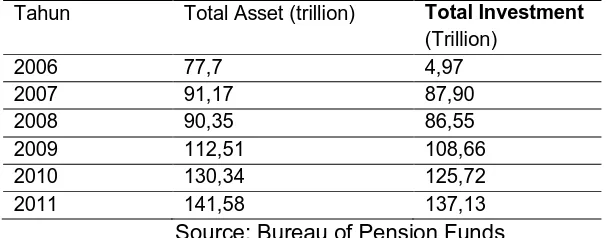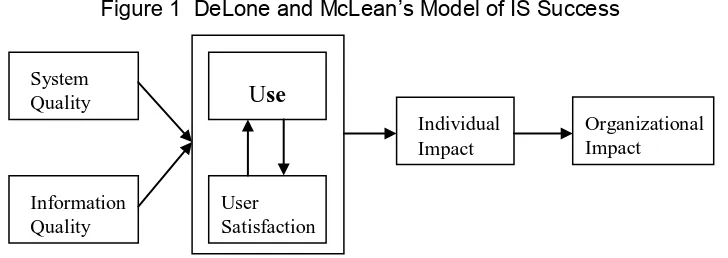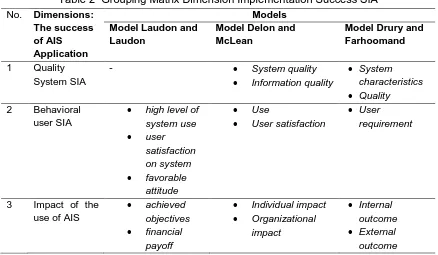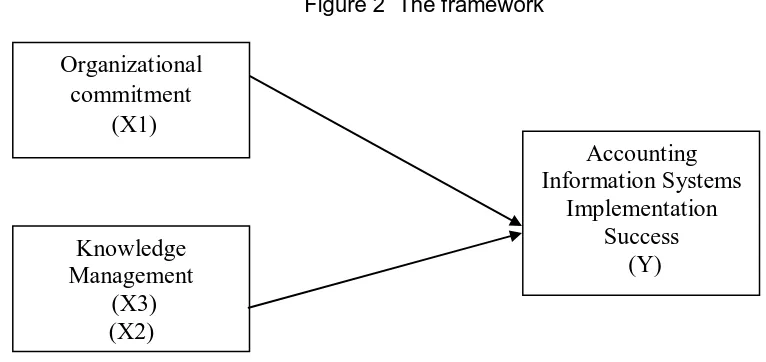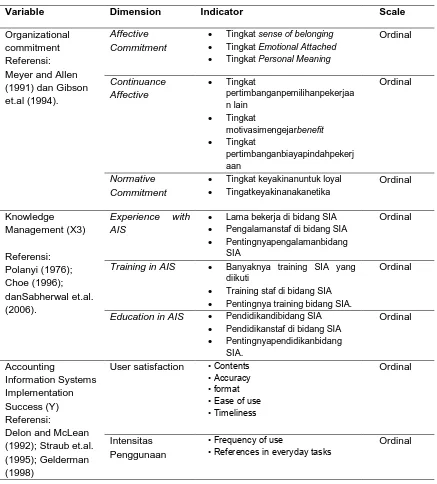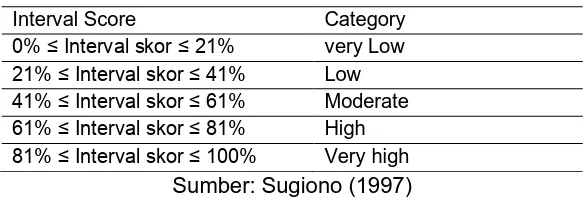Licensed under Creative Common Page 1
http://ijecm.co.uk/
ISSN 2348 0386
INFLUENCE OF ORGANIZATIONAL COMMITMENT
AND KNOWLEDGE MANAGEMENT ON SUCCESSFUL
IMPLEMENTATION OF ACCOUNTING INFORMATION SYSTEMS
IN THE EMPLOYER PENSION FUNDS HELD DEFINED BENEFIT
PENSION PLAN (PPMP) DIPROPINSI WEST JAVA, INDONESIA
Nunung Nurhayati
Doctoral Study Program in Accounting, Faculty of Economics and Business Padjadjaran University, Bandung, Indonesia
nunungunisba@yahoo.co.id
Abstract
This study was conducted to determine the effect of organizational commitment and knowledge management on the successful implementation of accounting information systems. The usefulness of this research is to develop science and problem solving in the given context. The results obtained through descriptive analysis, showed that the organizational commitment, knowledge management and the successful implementation of accounting information systems in pension funds employer defined benefit pension plans are basically still inadequate. This is because of the persistence of some pension funds that are late in submitting financial statements that because the system used to access existing financial reporting delivery started in pension funds are still many who have not integrated with each other, which affect the financial statements can not be delivered in a timely manner. While the analytical verification of test results obtained simultaneously or with -same turns organizational commitment and knowledge management significantly affect the successful implementation of accounting information systems in employer pension funds that held Benefit Pension definitely (PPMP)
Licensed under Creative Common Page 2
INTRODUCTION
In the era of globalization we are faced with a lot of competition among the competition between countries, between companies, in more detail product competition. To obtain a product that can compete then the company needs to have a quality management. Quality management system must have information.
In the management of the organization, a company needs information system designed to help the organization in the face of competition. System information is a collection of subsystems both physical and non-physical that relate to each other and work together in harmony to achieve one goal of process data into useful information (Azhar, 2008; 52). As one component in a company, then the information system must be able to interact properly and harmoniously with the various other components within the company. Therefore, companies should design and implement information systems after the company's condition.
In theory the accounting information system success is influenced by individual factors and systems (hardware, software, network procedures, tasks and others. Individual factors are associated with human use of accounting information system that in itself contained a humanitarian aspect that has the desire, willingness, motivation , likes and sukua, satisfied and dissatisfied, which in practice affect behavior in the use of the accounting information system Igrabia (1984) and Thompson et.ai (1990).
The complexity of the process of accounting information systems requires experience a financial manager in the AIS (experience with AIS) and SIA training (training in AIS), both of which construct (user related constructs) that determine the success of the application of accounting information systems (Shaberwal et.al., 2006 ). Training and education developers, managers, and users of accounting information systems (training and education developers, owners and users) is a critical success factor accounting information system implementation in the company, because with a completely SIA and various financial transactions that occur in all parts of the company requires careful management and continuous, in order to produce the financial statements are valid (According to Choe, 1996). While Saunders and Jones (1992), uses the term competence of managers and staff of accounting information systems (AIS manager and staff competence) as determinants of successful application of accounting information systems.
Licensed under Creative Common Page 3 Governor of Bank Indonesia, Hadad Darmansyah Hadad (2006) BI found four weak points in the customer service wealth management ... First, the weakness of the top management in carrying out the review or periodic review, and oversight of policies, consistent implementation of standards operational procedure (SOP) and internal control banks. Second, weaknesses in the implementation of policies, systems and procedures, and policies of human resources (HR) as weak implementation of the principle of know your employee.
The interest of researchers to examine in pension funds, is considered important because the total pension fund has been so great in Indonesia. The following are the total assets and total investment of pension fund institutions that exist d Indonesia in Table 1.
Table 1 Total Assets and Total Investment Institutions Pension Fund in Indonesia (2006-2011) Tahun Total Asset (trillion) Total Investment
(Trillion)
2006 77,7 4,97
2007 91,17 87,90
2008 90,35 86,55
2009 112,51 108,66
2010 130,34 125,72
2011 141,58 137,13
Source: Bureau of Pension Funds
The total assets of the Pension Fund to 2011, the average growth per year pension fund assets capable of reaching 17%. This is a positive impact, because with the increase in assets, the role of pension funds in the national economy has increased. In addition to having a role as funding from the participants, the pension fund has a pretty big responsibility, because this institution has been trusted by the participants to manage their funds Leave. One of the most mandatory responsibilities of this institution is to make the financial statements. Therefore, to meet the criteria accountable Lambaga pension funds, one of which financial statements are qualified, then it must satisfy the qualitative characteristics of financial statements is relevant, reliable, comparable, timely and understandable.
Licensed under Creative Common Page 4
Statement of problem
Based on the phenomenon, theories and previous studies, the formulation of the problems that exist in this research is: how much influence organizational commitment and knowledge management exert on the successful implementation of accounting information systems on employer pension fund that menyelenggrakan Defined Benefit pension plan (PPMK) in West Java?
Objective of study
Based on the formulation of the problem that exists in the research objectives of this study were: to determine the influence of organizational commitment and knowledge management on the successful implementation of accounting information systems on employer pension fund that menyelenggrakan Defined Benefit pension plan (PPMK) in West Java?
LITERATUR REVIEW
Organizational Commitment
Definition of Organizational Commitment
Mathis and Jackson (2004) organizational commitment is the level of trust and acceptance of employees on the organization's goals and desires owned to remain in the organization. DovElizur and MeniKoslowsky (2001) explains that organizational commitment is involved, emotional and functional, employees of the organization, and commitment is a manifestation of their own individual interests and reflect the default value is the basis for the existence of the individual as a person. Paul Currie and Brian Dollery (2006) organizational commitment is a construct that describes the search for consistency involves understanding the attitudes, beliefs and engagement behavior and its impact to a rejection of a viable alternative in the implementation by the employees in the organization. McShane and Von Glinow (2000) revealed that organizational commitment is an emotional state employees to identify and engage with the organization. According to Meyer and Allen (1991), organizational commitment is a sense of obligation to be on the organization's employees, the feelings resulting from the internalization of the individual normative pressure at the time of entry of the organization.
Dimensions of organizational commitment
Model Meyer and Allen (1991) for organizational commitment: 1. Affective Commitment.
Licensed under Creative Common Page 5 activities. According to Meyer and Allen (1997) attachment causes affective commitment to the organization include individual, organizational characteristics, work experience but according to Meyer and Allen (1997), shows that the strongest evidence found in the cause in the form of work experience. It shows more and more work experience as well as experience in dealing with the challenges of the job is getting commitments.
2. Continuance commitment
Continuance commitment associated with the desire to continue to work or even leave the organization. Meyer and Allen (1997), affective commitment and continuance commitment reflects the relationship between the employee and the organization which lowers turnover, but the nature of the relationship is different, employees who have a strong affective commitment will remain in the organization because they want it, while those who are committed will remain in the organization because they have to do. Mowday, et al (in Meyer & Allen, 1997), reveals those who want to remain in the organization would be willing to do the extra roles for the sake of the organization, but they are forced to survive in the organization to avoid the high cost and not a lot of extra roles.
3. Normative commitment
Normative commitment is a feeling of attachment to continue to be a member of the organization. Member organizations with high normative commitment will become members of the organization because he felt he had to be in the organization.
knowledge Management
Knowledge Management Definition
According to Indonesian dictionary essay Hasan et al (2003), knowledge is defined as everything that is known or intelligence. According Notoatmodjo (2003) knowledge is the result of out and do occur after the sensing of the specified object. Sensing occurs through human senses, namely the senses of sight, hearing, smell, taste, and touch. Most human knowledge gained through the eyes and ears.
Licensed under Creative Common Page 6 Jones (1992), knowledge in the field of accounting information systems manager is identical to the manager competence in the field of accounting information systems.
Knowledge Management Dimention
According to Polanyi (1976) in Ambrosini and Bowman (2001), in general, there are two dimensions of knowledge, namely:
1. Tacit knowledge,
Tacit knowledge is knowledge of the characteristics: a. Stored in the human mind.
b. Difficult formulated (eg an individual's expertise). c. It is important for creativity and innovation.
d. Converted into explicit knowledge by means of externalization. 2. Explicit knowledge is knowledge that has the characteristics: a. Can codified / formulations.
b. Can be converted to a tacit understanding and absorption.
The success of the application of Accounting Information Systems
Definition of Accounting Information Systems
Accounting information system is a collection of sub-systems that are interconnected to each other and work together in harmony to reach one goal, which is to process financial data into financial information (AzharSusanto: 2013: 72) (Wilkinson, 2000: 5) accounting information system is Data collection and processing procedures that create the necessary information to users. (Nancy 2010: 5) Accounting Information Systems is a subsystem of financial transactions and non-financial transaction processes that directly affect the financial transaction processing (James A. Hall, 2011: 7).
Successful Implementation of Accounting Information Systems
Licensed under Creative Common Page 7 information systems in daily work and satisfaction of users (user satisfaction) on the use of accounting information systems. Then and Straub et al (1995) defines the successful application of the accounting information system as an intention-use and user satisfaction.
In this study the definition of the successful application of accounting information systems refers to Straub, et.al. (1995) and Gelderman (1998), where the successful application of accounting information systems is the intensity of use (intended use) accounting information systems in a variety of managerial tasks and user satisfaction (user satisfaction) of the information generated by the accounting information system.
Dimensions of Implementation of Accounting Information Systems
In theory there are two comprehensive model that can be referred to the dimensions of the successful implementation of accounting information systems, namely: (1) Information Success Model of Delone and McLean (1992); and (2) Hierarchical Structural Model of Drury and Farhoomand (1998). Besides these two models, Laudon and Laudon (2000) gives five dimensions to measure the success of the implementation of accounting information systems, these dimensions are: (1) a high usage rate (high level of system use); (2) Satisfaction of users of the system (user satisfaction on the system); (3) A positive attitude (favorable attitude) users of the system; (4) The achievement of the objectives of information systems (Achieved objectives); and (5) yield a financial return (financial payoff) .Information Success Model of Delone and McLean (1992), stated that the success of an information system is represented by: (1) the qualitative characteristics of the information system itself (system quality); (2) The quality of the output of the system information (information quality); (3) The consumption of the output (use); (4) The response of the system user information (user satisfaction); (5) Effect of the customs information system users (individual impact); and (6) The impact on the performance of the organization (organizational impact). Figure 2.3 below shows the model of information systems success proposed by DeLone and McLean (1992).
Figure 1 DeLone and McLean’s Model of IS Success
Source : DeLone and McLean (1992)
Organizational Impact
U
se
Individual Impact
Information Quality
User Satisfaction System
Licensed under Creative Common Page 8 Dimensions success implementation SIA can be grouped into three main aspects, namely: (1) the quality aspect of the AIS system (hardware); (2) behavioral aspects AIS users; and (3) Aspects of the impact of the use of AIS. Table 2 below provides a matrix of grouping dimension SIA successful application of three-dimensional model of the successful implementation of SIA above.
Table 2 Grouping Matrix Dimension Implementation Success SIA No. Dimensions:
The success of AIS Application
Models Model Laudon and
Laudon
Model Delon and McLean
Model Drury and Farhoomand
1 Quality System SIA
- System quality
Information quality
System characteristics
Quality
2 Behavioral user SIA
high level of system use user satisfaction on system favorable attitude Use
User satisfaction
User requirement
3 Impact of the use of AIS
achieved objectives
financial payoff
Individual impact
Organizational impact Internal outcome External outcome
From Table 2 it appears that the three-dimensional model of the successful implementation of accounting information systems, behavioral aspects of users SIA and SIA aspects of the impact of using an existing dimension of the three models. In the context of this study used behavioral aspects of users SIA (intensity of use and user satisfaction) to measure the dimensions of the successful implementation of SIA, it is because of the emphasis of this research is to look at the effect of behavioral aspects in the use of accounting information systems.
Influence of Organizational Commitment and Knowledge Management on Successful Application of Accounting Information Systems
Licensed under Creative Common Page 9 company. Furthermore Clercq and Dimov (2008) conducted a study with the results; Development of internal knowledge and access to internal knowledge affect the performance of investment finance company. Marpaung, Renopa (2011) There is a significant relationship between organizational culture and organizational commitment on employee job satisfaction. Based on the description above, the framework of this study can be described as Figure 2 below.
Figure 2 The framework
METHODELOGY
In this study, the type of research is descriptive and verification. Descriptive research is basically a study to obtain descriptive of the characteristics of the variables. Semenetara the verification research is a type of research that aims to determine the relationship between variables through a testing ipotesis. In connection with this kind of research, the research method used is a survey method (Singarimbun and Effendi, 1995).
Operationalization of Variables
The variables used in this study are as follows: Organizational Commitment (X1). Variables of organizational commitment consists of three dimensions, namely: (1) Affective commitment (2) continuance commitment and (3) Normative commitment. Knowledge Manager (X2). Variable Manager Knowledge consists of three dimensions, namely: (1) Experience with AIS (X2.1); (2) Training in AIS (X2.2); and (3) Education in AIS (X2.3). The success of Accounting Information System Implementation (Y). Variable successful application of accounting information system consists of two dimensions, namely: (1) user satisfaction (user satisfaction) on the accounting information system (2) The intensity of use (intended use) of accounting information systems.
Organizational
commitment
(X1)
Knowledge
Management
(X3)
(X2)
Accounting
Information Systems
Implementation
Success
Licensed under Creative Common Page 10 Below are summarized the following research variables dimensions, indicators and scale of measurement that will be used, as in Table 3 below:
Tabel 3 Operationalization of Variables
Variable Dimension Indicator Scale
Organizational commitment Referensi: Meyer and Allen (1991) dan Gibson et.al (1994).
Affective Commitment
Tingkat sense of belonging
Tingkat Emotional Attached
Tingkat Personal Meaning
Ordinal Continuance Affective Tingkat pertimbanganpemilihanpekerjaa n lain Tingkat motivasimengejarbenefit Tingkat pertimbanganbiayapindahpekerj aan Ordinal Normative Commitment
Tingkat keyakinanuntuk loyal
Tingatkeyakinanakanetika Ordinal Knowledge Management (X3) Referensi: Polanyi (1976); Choe (1996); danSabherwal et.al. (2006).
Experience with AIS
Lama bekerja di bidang SIA
Pengalamanstaf di bidang SIA
Pentingnyapengalamanbidang
SIA
Ordinal
Training in AIS Banyaknya training SIA yang diikuti
Training staf di bidang SIA
Pentingnya training bidang SIA.
Ordinal
Education in AIS Pendidikandibidang SIA
Pendidikanstaf di bidang SIA
Pentingnyapendidikanbidang SIA. Ordinal Accounting Information Systems Implementation Success (Y) Referensi:
Delon and McLean (1992); Straub et.al. (1995); Gelderman (1998)
User satisfaction • Contents • Accuracy • format • Ease of use • Timeliness
Ordinal
Intensitas Penggunaan
• Frequency of use
• References in everyday tasks Ordinal
Data Collection Techniques
Licensed under Creative Common Page 11 systems managers as respondents in this study is because the manager SIA is the most understand the process of development and implementation of the company SIA pension funds.
Population and Sample
According to Kerlinger (1992), the population is set, while the set is referred to in the study can be objects, humans, symptoms, events, or other things that have certain characteristics to clarify the research problem. Meanwhile, according to Cooper and Schindler (2006: 717) population is the entire collection of elements that can be used to make some conclusions. The set of elements is basically an object in which the observations will be conducted by researchers. The target population in the research is the employer pension funds that held PPMP. The number of pension funds which menyelenggrakan PPMP in West Java there are 26 institutions. In this study the use of research undertaken all populations, after the spread of questionnaires to 26 institutions and returned to the researchers only 21 institutions.
Analytical approach
This study will analyze the pattern of causal relationships between variables of the study. Research methods using analytical tools as follows: Test Instrument Research (Validity and Reliability Test), Descriptive Analysis (provide a descriptive overview of the primary data obtained from respondents). Verification analysis using statistical analysis tools consisting of: Classical Assumption Test (multiple regression analysis, it is necessary to test the assumptions required in the multiple regression analysis to meet the criteria of a good if it has the criteria BLUE (Best Linear unbias Estimate) include; Test normality, multicollinearity, heteroscedasticity test, test assumptions Classic autocorrelation), hypothesis Testing (Testing hypotheses used multiple linear regression. simultaneous hypothesis Testing basis (test F Statistics)). Verification analysis using statistical tools and assisted in the processing of this data with SPSS software 21
ANALYSIS AND FINDINGS Descriptive Analysis
Licensed under Creative Common Page 12 Tabel 4 Criteria Category interval Score
Interval Score Category
0% ≤ Interval skor ≤ 21% very Low 21% ≤ Interval skor ≤ 41% Low 41% ≤ Interval skor ≤ 61% Moderate 61% ≤ Interval skor ≤ 81% High 81% ≤ Interval skor ≤ 100% Very high
Sumber: Sugiono (1997)
The results of calculations grand mean score of respondents regarding organizational commitment instituted employer pension fund awarding Defined Benefit Pension Plan of 3.51 or 70.11% and is in the interval 61% - 80%. It can be concluded that organizational commitment in most employer pension funds that held Defined Benefit Pension Plan (PPMP) across West Java has been good. The results of calculations grand mean score of respondents regarding the knowledge manager instituted employer pension fund awarding Defined Benefit Pension Plan of 3.51 or 70.16% and is in the interval 61% - 80%. It can be concluded that the knowledge managers in most employer pension funds that held Defined Benefit Pension Plan throughout West Java has been good. The results of calculations grand mean score of respondents regarding the knowledge manager instituted employer pension fund awarding Defined Benefit Pension Plan of 3.39 or 74.05% and is in the interval 61% - 80%. It can be concluded that the successful implementation of accounting information systems in most employer pension funds that held Defined Benefit Pension Plan throughout West Java has been good.
Verification analysis
Influence of Organizational Commitment and Knowledge Management on Accounting Information Systems’ Implementation success simultaneously.
F-test was used to test significant influence simultaneously or the entirety of all the variables, organizational commitment and knowledge manager for the successful implementation of accounting information systems in employer pension funds that held PPMP in West Java, with the formulation of statistical hypotheses as follows:
1) Hypothesis Formulation Variables
H0 :β1,β2=0,Organizational commitment and knowledge manager together / simultaneous does
not affect the successful implementation of accounting information systems.
Hi: β1, β2,> 0, organizational commitment and knowledge manager together berpengaaruh to
Licensed under Creative Common Page 13 2) Determine significant levels and testing, which is at a significant level of 5% was
obtained F Table 3.55
3) Determine the magnitude of F obtained from the test results with SPSS. The resulting value of F is equal to .6,641
Tabel 4 Table Testing in Simultaneous
ANOVAb
Model
Sum of
Squares Df Mean Square F Sig.
1 Regression 362.893 2 181.447 6.641 .007a
Residual 491.774 18 27.321
Total 854.667 20
a. Predictors: (Constant), pengetahuan, komitment Dependent variable: Success Implemantasi SIA Criteria Testing α
Accept H0: if F count <Ftable Reject H0: if F count> F table
4) Based on the table above 4:26 obtained F value of 6.641 while the F table with α = 0.05
and 2 and 18 degrees of freedom obtained F value table by 3.55. This means that F count (6.641) is greater than the F table (3.55), or if it is seen Sig value 0.007 <0.05, it was decided to reject Ho and accept Ha
5) Conclusion: Based on the 5% significance level of the test result is stated that there is simultaneously a significant relationship between organizational commitment and knowledge manager for the successful implementation of accounting information systems instituted a pension fund employer defined benefit pension plans as a significant difference.
Licensed under Creative Common Page 14 West Java. While the remaining 63.9% influenced by other factors that are not observed, ie the influence of other factors beyond the two independent variables studied.
The results of testing the effect of Organizational Commitment and Knowledge Manager for Accounting Information Systems Implementation Success by Simultaneous shows that the value of F = 6.641> F table = 3.55, where the decision to reject the hypothesis testing the null hypothesis and accept the hypothesis Ha. Based on these test results, it can be concluded that the statistically variable Organizational Commitment and Knowledge Manager together positive and significant impact on the success of Accounting Information Systems Implementation.
CONCLUSION
Based on test results simultaneously or with -same turns; organizational commitment and knowledge management significantly affect the successful implementation of accounting information systems in employer pension funds that held Benefit Pension definitely (PPMP). Organizational commitment and knowledge management collectively explain the 36.15 variance in the AIS implementation success, while the remaining 63.9% influenced by other factors that are not observed.
REFERENCES
Ambrosini, V.,& Bowman, C. 2001. Tacit Knowledge: Some Suggestions for Operationalization. Journal of Management Studies, 38(6): 811-829.
AzharSusanto. 2007. Sistem informasi Manajemen: Konsep dan Pengembangannya. Edisi 3. Bandung: Lingga Jaya.
______________. 2008. Sistem informasi Akuntansi: Struktur Pengendalian Resiko Pengembangan. Edisi Perdana. Bandung: Lingga Jaya.
Barker, C., Pistrang, N., and Elliot, R. 2002.Research Methods in Clinical Psychology: An Introduction for Students and Practitioners. 2th Edition. England: John Wiley & Sons, Ltd.
Burton, F. G., Chen, Y., Grover, V., and Steward, K.A. 1992. An Application of Expectancy Theory for Assesing User Motivation to Utilize an Expert System. Journal of Management Information System. 9 (3): 183-198.
Cerullo, M.J. 1997. Information Systems Success Factors.Journal of Systems Management.31(12): 10-19.
Chan, Y.L. 2004. Performance Measurement and Adoption of Balance Scorecard: A Survey of Municipal Governments in the USA and Canada. The International Journal of Public Sector Management. 17(3): 204-221.
Chang, J.C., and King, W.R. 2005. Measuring The Performance of Information System: A Functional Scorecard. Journal of Management Information. 24(2): 263-275.
Chen, Z.X., Tsui, A.S., and Farh, J.L. 2002. Loyality to Supervisors vs. Organizational Commitment: Relationships to Employee performance in China. Journal of Occupational and Organizational Psychology. 75: 339–356.
Licensed under Creative Common Page 15 Choe, J.M. 1996. The Relationship Among Performance of Accounting Information System, Influence Factors, and Evolution Level of Information System. Journal of Management Information System. 12(4): 215-239.
Clercq, D.D., and Rius, I.B. 2007. Organizational Commitment in Mexican Small and Medium-Sized Firms: The Role of Work Status, Organizational Climate, and Entrepreneurial Orientation. Journal of Small Business Management. 10(2): 185-210.
Delone, W.H.,and McLean. 1992. Information Systems Success: The Quest for the Dependent Variable.
Information Systems Research. 3(1): 60-95.
Dessler, G. 2003. Human Resource Management.New Jersey: Prentice Hall, Upper Saddle River, NJ. Dixon, J.R., Nanni, A.J., and Vollman, T.E.1990. The New Performance Challenge: Measuring Operations for World-Class Competition. Illionise: Business One Irwin. Homewood.
Doll, W.J. 1995. Avenues for Top Management Involvement in Successful MIS Development. MIS Quarterly. 9(1): 17-35.
Etezadi-Amoli, J., and Farhoomand, A.F. 1996.A structural model of end user Computing Satisfaction and User Performance.Information & Management.30(2): 65–73
Etty Murwaningsari. 2008. The Role of Organizational Commitment and Procedural Justice in Moderating the Relationship Between Budgetary Participation and Managerial Performance. Gadjah Mada International Journal of Business. 10(2): 185-210.
Gelderman, M. 1998. The Relation Between User Satisfaction, Usage of Information Systems and Performance. Information & Management.34: 11-18
Gelinas, J.U., Allan, O.E., and William, W.P.1993. Accounting Information System. Second Edition, Cincinnati, Ohio: South-Western Publishing Co.
Gibson, J.L., Invancevich, J.M., and Donnelly, J.M. 1994. Organization Behavior: Structure and Process. Seventh Edition, Boston: Homewood, Richard D. Irwin.
Haar, J.M., and Spell, C.S. 2004.Programme Knowledge and Value pf Work-Family Practices and Organizational Commitment. The International Journal of Human Resource Management. 15(6): 1040-1055.
Hair, F., Joseph, R.E., Anderson, Ronal, L.T., and William C.B. 2006.Multivariat Data Analysis.9th Edition.Prentice Hall International Inc.
Hasan Alwi., Dendi Sugono,Adiwirmata, dan Sri Suseki. 2003. KamusBesarBahasa Indonesia.Jakarta: DepertemenPendidikanNasionaldanBalaiPustaka.
Kaplan, R.S., and Norton, D.P. 1996. The Balanced Scorecard: Translating Strategy into Action. Boston, Massachusetts: Harvard Business School Press.
Kaye, G.R. 1990. Information System Successes and Failures: Research Finding from the Compunding Industry. Jurnal of Information Technology. 5: 73-83.
Keller, R.T. 1997. Job Involvement and Organizational Commitment as Longitudinal Predictors of Job Performance: A Study of Scientists and Engineers. Journal of Applied Psychology. 82 (4): 539-545. Kennerly, Mike, and Neely, A. 2003.Measuring Performance in Changing Busnises Environment.International Journal of Operation and Production Management. 23(2): 213-230.
Kerlinger, F.N. 1992. Asas-AsasPenelitian Behavioral.Edisi Indonesia.CetakanKedua. Yogyakarta: GadjahMada University Press.
Kettinger, W. J., and Lee, C.C. Perceived Service Quality and User Satisfaction with the Information Services Function. Decision Sciences.25(5/6): 737-765.
Licensed under Creative Common Page 16 Larsen, K.R.T. 2003.A Taxonomy of Antecedents of Information Systems Implementation: Variable Analysis Studies.Journal of Management Information Systems.20(2): 169-246.
Lee, J.J., and Kim, S.H. 1992. The Relationship Between Procedural Formalization in MIS Development and MIS Success. Information and Management, 22(2): 89-111.
Livari, J. 2005. An Empirical Test of The Delone-McLean Model of Information System Success.
Database for Advance in Information System (DFA). ISSN: 1532-0936. Volume 36. ProQuest Company. Mathis, R.L., and Jackson, J.H. 2004. Human Resources Management. International Student Edition. South-Western, a division of Thompson Learning, Thompson Learning is a Trademark Used Herein Under License, In Singapore.
Masri Singarimbun,dan Sofian Effendi. 1995. MetodePenelitianSurvei. Edisi Ke-2. Jakarta: LP3ES. Mcshane, Steven L., and Von Glinow, M.A.2000. Organizational Behavior. USA: McGraw-Hill Companies, Inc.
Meyer, J. P., and Allen, N. J. 1991. A Three-Component Conceptualization of Organizational Commitment. Human Resources Management Review. 1: 61–89.
Mowday, R.T., Porter, L.W., and Steers, R.M. 1982. Employee-Organization Linkages. New York: Academic Press.
Neely, A., Gregory, M.J., and Platts, K.W. 1995. Performance Measurement System Design – A Literature Review and Research Agenda.International Journal of Operation and Production Management. 14(3): 140-152.
NurIndriantorodan Bambang Supomo. 1999. MetodePenelitianBisnis: UntukAkuntansidanManajemen. EdisiPertama. Yogyakarta: BPFE.
Porter, L.,and Lawler, E. 1968.Managerial Attitudes and Performance.Homewood, Ill: Dorsey Press. Rayner, R.K., and Watson, H.J. 1995. The Keys to Executive Information System Success.Journal of Management Information System. 12(2): 83-98.
Raymond L. 1990. Organizational Contex and Information System Success: A Contingency Approach.
Jurnal of Management Information System. 6(4): 5-20.
Romney, B.M., and Steinbart, J.P. 2009. Accounting Information System.Eleventh Edition. USA: Pearson Prentice Hall.
Sabherwal, R., Jeyaraj, A., and Chowa C. 2006. Information System Success: Individual and Organizational Determinants. Management Science. 52(12): 1849-1864.
Salama, A.I. 2003. A Median Regression Analysis of the Relationship Between Environmental Reputation and Corporate financial performance: Empirical Evidence on UK Firms. A Paper Presented at the rRensselaer Polytechnic Institute Confrerence, New York: October.
Saunders, C.S., and Jones, J.W. 1992. Measuring Performance of the Information Systems Function.
Journal of Management Information System. 8(4): 63-82.
Seddon, P.B., and Kiew, M.Y. 1994. A Partial Test and Development of Delone and McLean Model of IS Success. Proceding of The International Conference on Information System.
Sekaran, Uma. 2006. Research Method for Business: A SKil Building Appoach. Fourth Edition. New York: John Wiley & Sons Inc.
